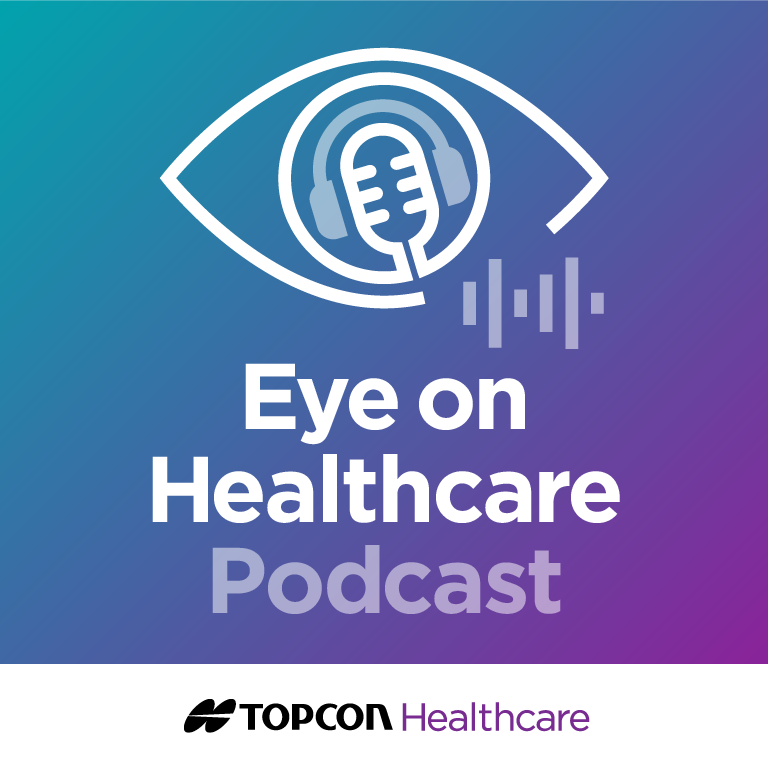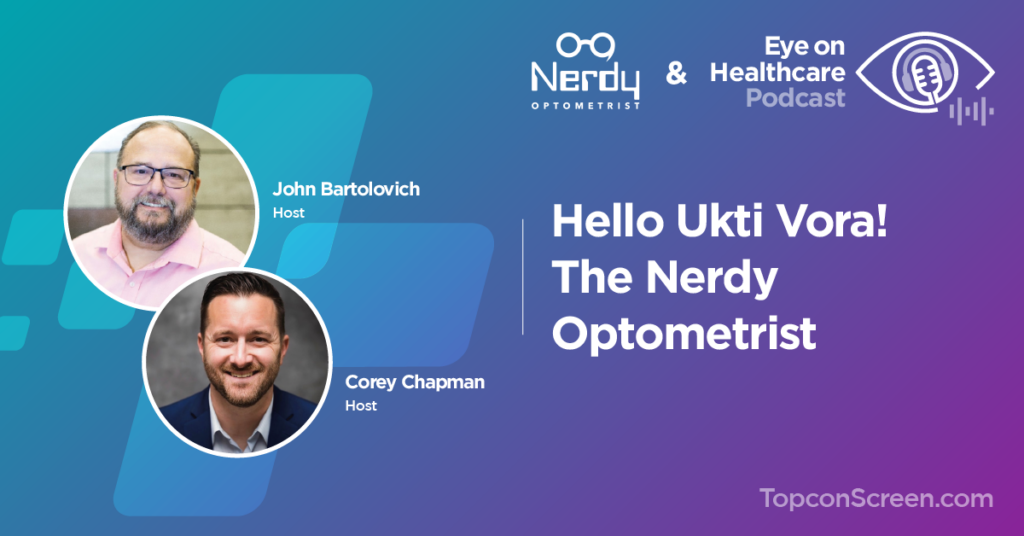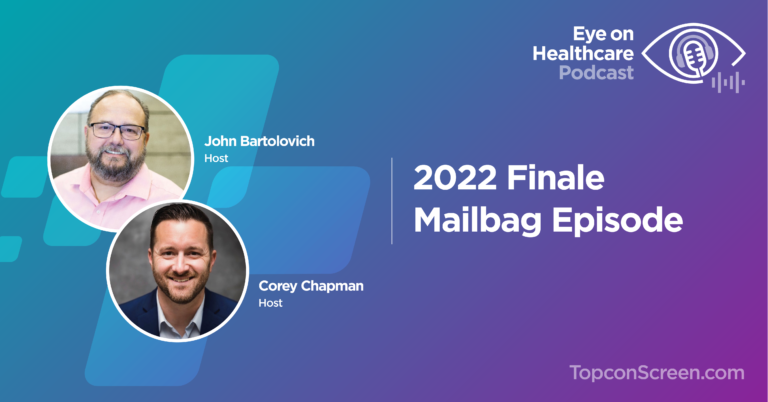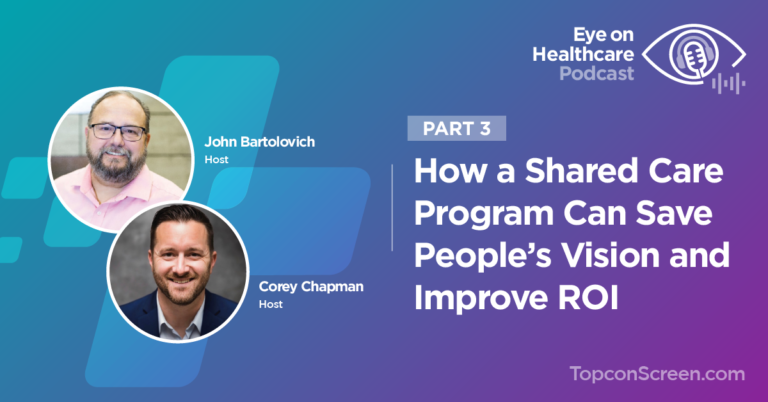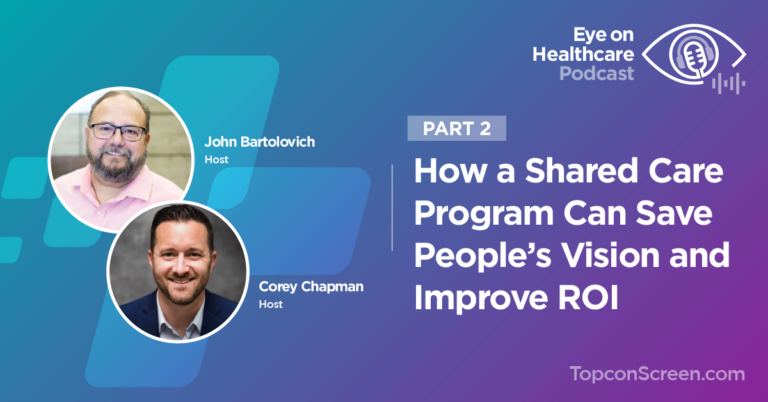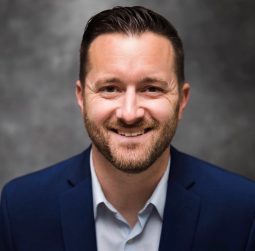Episode Transcript
Corey: Welcome back to another exciting episode of The Eye on Healthcare podcast. I’m your host Corey Chapman, back in the host seat. That’s right. It’s been a few weeks; we’ve taken a little bit of a hiatus during these summer months. I’m happy to have us back live. John Bartolovich, my co-host is here. Hi, John. How are you today?
John: I am doing great, Corey, and we could probably do weekly if you would give me the key keys to the podcast.
Corey Chapman: Well, you know, you need to be managed, John. I don’t know what you’re going to say if I, you know, if I’m on vacation and you turn the microphone on, you hit record, anything can go over the airwaves when you’re by yourself. You know you have to be managed. You say a lot of things that need to be edited.
John: I do have a shirt that says it’s your fault. I was left unsupervised.
Corey: Exactly. And I would be held responsible if you, you know, said some things that shouldn’t be said. So that’s why I’m here. I am the babysitter of this podcast. Sorry folks, that we’ve been gone a couple of weeks. I went ahead and took a little vacation. Back. Recharged, ready to go. Ready to continue on Topcon Weekly podcast on All Things healthcare. And John, while I was away. You did play, but you did play in a great way. You attended a conference in Baltimore, MD. Tell me about ADCES 2022. That’s a lot of letters and numbers.
John: Well, do you really want to know about conference or do you want to know about my encounter with Bigfoot? I can discuss either one.
Corey Chapman: Hmm. OK, hold on. Hold on. Hold on, hold on. Baltimore MD is not where I would hear, I would think, there be a Bigfoot? Sasquatch sighting. I think there’ll be like in, you know, the mountains of Colorado or down in the Blue Ridge Mountains or something like that. You’re telling me in Baltimore, MD, you saw a Bigfoot.
John Bartolovich: Absolutely. Not only did I see a Bigfoot, but I watched one of my colleagues perform a diabetic retinopathy exam utilizing the NW 400 on Bigfoot.
Corey Chapman: I got to hear this.
John Bartolovich: Well, there’s a company out there that Bigfoot is their mascot and while Bigfoot was walking around the venue, we were able to convince him to come in and get his eyes checked to see if he had diabetic retinopathy.
Corey Chapman: And he or she or it…. they were tamed? They were not, you know, Ravenous, ripping arms off of human beings. They were cool about it?
John Bartolovich: He was. He was. He was pretty cool, didn’t even flinch with the flash from the camera.
Corey Chapman: OK. Wow. OK. And did he have Dr or any other pathologies?
John Bartolovich: I’m not a doctor and I don’t play one. So, we have to get the exam interpreted. But you know it was a clean image.
Corey Chapman: Ah. But you answered that correctly because you’re not allowed to tell us anyway, right? That’s a part of HIPAA that is a privacy act. OK, so that’s interesting. Now, when there are Bigfoot sightings in the world you know, you don’t really believe it unless there’s video or picture proof. Is there any proof that this happened or you’re just telling a tall tale?
John Bartolovich: No. When we post the link for this on LinkedIn, I will include an image of Bigfoot getting his eye exam.
Corey Chapman: Umm. OK, alright. I can’t wait to see it.
John Bartolovich: But really, you’re more interested in the Association of Diabetes Care and Education Specialists meeting that took place in these couple weeks ago here, August 13th through the 15th in Baltimore, MD. And it was really, really a good show. I’m glad we went. It was a show focused on really all things prediabetes, diabetes and cardiometabolic care.
Corey Chapman: Yeah. OK, so for those who don’t know and, there are so many acronyms out there, what is ADCES?
John Bartolovich: Like I said it it’s the Association of Diabetes Care and Education Specialists. They are a 12,000 plus member strong organization and one of the interesting things about this organization. You listen to the title and you hear diabetes care and education specialists and they truly encompass that because their membership is made-up not only of educated diabetes care and educators, but they have nurses, they have pharmacists, they have dietitians, and they have other healthcare professionals that really get involved with trying to improve the integrated care model.
Corey Chapman: OK. And that was going to be my next question, what are they made-up of? I immediately think of certified diabetic educators, but you’re telling me that it’s a lot of different folks, nurses and pharmacists and things of that nature. Now, are they all again, I’m not being in attendance, are they all representatives of large health systems or how does that work? How do they, you know, what are they doing there and who are they representing?
John Bartolovich: Yeah, it was interesting because not only did we see folks from large health systems, but we also saw some small independent practitioners. You know, there were folks there representing the federal government and the VA system, Indian Health service. I know you had just attended a meeting; we had some folks that were affiliated with the Indian Health Service and one of the really interesting encounters we had was there was a representative from an employer in Pennsylvania that is looking at employer health and how to manage chronic disease at the employer on site Health Clinic.
Corey Chapman: Oh wow. OK. That’s fantastic. OK. So, tell me, you know, I’m sure these three days were fairly busy outside of the Bigfoot sighting. What sort of discussions did you have with these members?
John Bartolovich: Well, you know these members were there to learn about all kinds of things. There was a lot of representation from, you know, glucose monitoring and insulin manufacturers. And so, there was a lot of good discussion for the attendees around that. But what really sparked them to come and talk to us is we were there talking solely about diabetic retinopathy and the, you know, spreading the gospel of the importance of doing this exam at primary care and eliminating long term complications.
Corey Chapman: OK. And how was that received? I mean you know typically when we talked to CD’s they are obviously a champion for the diabetic patient population. This is a service that’s been around in primary care for quite a long time. Is it something that was received like oh, this is new to us, we’re not familiar with it or oh yeah, we’ve been trying to get something like this in our system for a long time?
John Bartolovich: There was a little bit of both. I would say for the for the most part it was how do we get this into our system? We know that this is important. We know it needs to be done. What type of help can you give us to get this type of point of care testing into our systems? So, I would say that was probably about 65-70% of it, but as I said, we did have some entities that you know this was new to them and they’re looking for ways that they can control cost and improve outcomes when it comes to chronic care and as we’re all aware, point of care testing works. It’s worked in kidney testing. It’s worked in HB A1C testing. It works and the best way to close these care gaps and to prevent diabetic retinopathy as well as other eye disease is through point of care testing at the primary care or where the patient goes most. Be that the odd side work clinic, the primary care. They have QFC.
Corey: So, you know we talked to doctors and nurses and CDs and, you know, champions for diabetics all the time, right. And we have conversations daily with them and you know what I see the comment it always is, I got into medicine to treat patients, right? and the business side of it and the checks and balances is clearly a part of what everybody does and it sometimes it drives you know business, right. When you are talking to these particular members and they are clearly an influencer for their health systems, and again, I know this is going to vary, but are they tied into the business side of it in the respect of yeah, we’re here 100%. I want to make sure that our diabetic patients are treated the best and they’re getting tested and everything. But are they dialed into the population health piece? Are they dialed into the compliance of that or is that typically separate? because the way I think about John is when they go back to the health system, they saw all these great technologies in Baltimore and they think this is going to work. Did you get a sense in your conversations that they understand and respect that part of it and can be that influence on the on the business side of it as well?
John Bartolovich: Absolutely. You know ADCES is really… they’ve been a leader in building this country’s diabetes prevention infrastructure and they know that they’re not always going to be able to prevent it. So, when they do have a patient, you know what we do have patients living with diabetes, they’re prone to have a lot of things potentially go wrong if they’re not treated. So yes, these members, this membership, is dialed into population health and quality and really committed to driving the best possible care for their patients living with diabetes.
Corey Chapman: Excellent. OK. And you know the reason I bring that up is you know in our dealings, there’s nobody more passionate about the care of patients living with diabetes than this type of group right there. You know, the biggest champion for them and I know sometimes it just gets lost in the sauce, that there’s a business aspect of it and helping out. So, this is really great to know that they are on the front lines of helping diabetes patients with this. So, this is fantastic.
John Bartolovich: Yeah, I mean it’s, you know, they’re part of an integrated care team and it cannot be overlooked the importance of what they do and how they help primary care treat diabetics and people living with diabetes.
Corey Chapman: Excellent. OK, alright, John, thank you for the recap. Heard the team had a lot of fun, good time, a lot of great discussions. I mean, heck a Bigfoot sighting. You can’t beat that. Really you can’t top that. But we are going to try to top that. We Topcon Screen is going to be at FMX which is the family medicine show. The National conference is coming up in September. We will be exhibiting the 21st through the 23rd at the Walter E Washington Convention Center in exhibit Halls A&B, so definitely come by and see us. I mean if you are a mythical creature, if you are, you know something that’s cooler than Bigfoot. Please come on by, we will absolutely screen your eyes. You know a Centaur would be awesome to land. You know, that’d be kind of cool. I’m just trying to think like a goblin. If there’s goblins out there, you know, whatever. You know, we’re getting into the fall. You know, Halloween season, a specter. I would love to be able to say that we have successfully screened the eyes of a diabetic ghost. So…
John Bartolovich: or Hobbit.
Corey Chapman: or a Hobbit. Would be interesting. Yeah. It’s tough to ask if, you know. Are you a Hobbit? You know what are you asking me that for? No, I just have pointy ears. You know, there’s so many different things. Umm, but yeah, definitely come visit the team in Washington DC at the end of September and we’ll be doing a recap on that, but we’ll have episodes in between. Of course, this is the weekly podcast put on by Topcon here. So, John, any closing thoughts before we disembark this mission?
John Bartolovich: No looking forward to our next episode and interested to find out what we’ll be talking about and look forward to hearing a recap 4 weeks from now when you come back from FMX.
Corey Chapman: Fantastic. So, for John Bartolovich, I’m Corey Chapman. Thanks again for listening to the Eye on Healthcare podcast. We’ll talk to you soon.
John Bartolovich: Thanks everybody.

